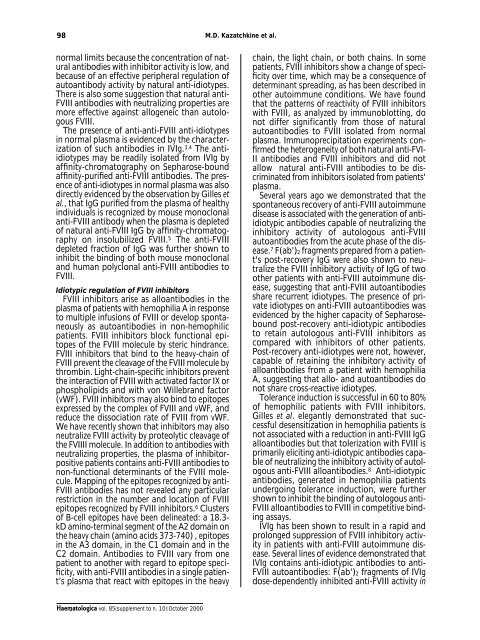Haematologica 2000;85:supplement to no. 10 - Supplements ...
Haematologica 2000;85:supplement to no. 10 - Supplements ...
Haematologica 2000;85:supplement to no. 10 - Supplements ...
You also want an ePaper? Increase the reach of your titles
YUMPU automatically turns print PDFs into web optimized ePapers that Google loves.
98<br />
M.D. Kazatchkine et al.<br />
<strong>no</strong>rmal limits because the concentration of natural<br />
antibodies with inhibi<strong>to</strong>r activity is low, and<br />
because of an effective peripheral regulation of<br />
au<strong>to</strong>antibody activity by natural anti-idiotypes.<br />
There is also some suggestion that natural anti-<br />
FVIII antibodies with neutralizing properties are<br />
more effective against allogeneic than au<strong>to</strong>logous<br />
FVIII.<br />
The presence of anti-anti-FVIII anti-idiotypes<br />
in <strong>no</strong>rmal plasma is evidenced by the characterization<br />
of such antibodies in IVIg. 3,4 The antiidiotypes<br />
may be readily isolated from IVIg by<br />
affinity-chroma<strong>to</strong>graphy on Sepharose-bound<br />
affinity-purified anti-FVIII antibodies. The presence<br />
of anti-idiotypes in <strong>no</strong>rmal plasma was also<br />
directly evidenced by the observation by Gilles et<br />
al., that IgG purified from the plasma of healthy<br />
individuals is recognized by mouse mo<strong>no</strong>clonal<br />
anti-FVIII antibody when the plasma is depleted<br />
of natural anti-FVIII IgG by affinity-chroma<strong>to</strong>graphy<br />
on insolubilized FVIII. 5 The anti-FVIII<br />
depleted fraction of IgG was further shown <strong>to</strong><br />
inhibit the binding of both mouse mo<strong>no</strong>clonal<br />
and human polyclonal anti-FVIII antibodies <strong>to</strong><br />
FVIII.<br />
Idiotypic regulation of FVIII inhibi<strong>to</strong>rs<br />
FVIII inhibi<strong>to</strong>rs arise as alloantibodies in the<br />
plasma of patients with hemophilia A in response<br />
<strong>to</strong> multiple infusions of FVIII or develop spontaneously<br />
as au<strong>to</strong>antibodies in <strong>no</strong>n-hemophilic<br />
patients. FVIII inhibi<strong>to</strong>rs block functional epi<strong>to</strong>pes<br />
of the FVIII molecule by steric hindrance.<br />
FVIII inhibi<strong>to</strong>rs that bind <strong>to</strong> the heavy-chain of<br />
FVIII prevent the cleavage of the FVIII molecule by<br />
thrombin. Light-chain-specific inhibi<strong>to</strong>rs prevent<br />
the interaction of FVIII with activated fac<strong>to</strong>r IX or<br />
phospholipids and with von Willebrand fac<strong>to</strong>r<br />
(vWF). FVIII inhibi<strong>to</strong>rs may also bind <strong>to</strong> epi<strong>to</strong>pes<br />
expressed by the complex of FVIII and vWF, and<br />
reduce the dissociation rate of FVIII from vWF.<br />
We have recently shown that inhibi<strong>to</strong>rs may also<br />
neutralize FVIII activity by proteolytic cleavage of<br />
the FVIIII molecule. In addition <strong>to</strong> antibodies with<br />
neutralizing properties, the plasma of inhibi<strong>to</strong>rpositive<br />
patients contains anti-FVIII antibodies <strong>to</strong><br />
<strong>no</strong>n-functional determinants of the FVIII molecule.<br />
Mapping of the epi<strong>to</strong>pes recognized by anti-<br />
FVIII antibodies has <strong>no</strong>t revealed any particular<br />
restriction in the number and location of FVIII<br />
epi<strong>to</strong>pes recognized by FVIII inhibi<strong>to</strong>rs. 6 Clusters<br />
of B-cell epi<strong>to</strong>pes have been delineated: a 18.3-<br />
kD ami<strong>no</strong>-terminal segment of the A2 domain on<br />
the heavy chain (ami<strong>no</strong> acids 373-740) , epi<strong>to</strong>pes<br />
in the A3 domain, in the C1 domain and in the<br />
C2 domain. Antibodies <strong>to</strong> FVIII vary from one<br />
patient <strong>to</strong> a<strong>no</strong>ther with regard <strong>to</strong> epi<strong>to</strong>pe specificity,<br />
with anti-FVIII antibodies in a single patient’s<br />
plasma that react with epi<strong>to</strong>pes in the heavy<br />
chain, the light chain, or both chains. In some<br />
patients, FVIII inhibi<strong>to</strong>rs show a change of specificity<br />
over time, which may be a consequence of<br />
determinant spreading, as has been described in<br />
other au<strong>to</strong>immune conditions. We have found<br />
that the patterns of reactivity of FVIII inhibi<strong>to</strong>rs<br />
with FVIII, as analyzed by immu<strong>no</strong>blotting, do<br />
<strong>no</strong>t differ significantly from those of natural<br />
au<strong>to</strong>antibodies <strong>to</strong> FVIII isolated from <strong>no</strong>rmal<br />
plasma. Immu<strong>no</strong>precipitation experiments confirmed<br />
the heterogeneity of both natural anti-FVI-<br />
II antibodies and FVIII inhibi<strong>to</strong>rs and did <strong>no</strong>t<br />
allow natural anti-FVIII antibodies <strong>to</strong> be discriminated<br />
from inhibi<strong>to</strong>rs isolated from patients'<br />
plasma.<br />
Several years ago we demonstrated that the<br />
spontaneous recovery of anti-FVIII au<strong>to</strong>immune<br />
disease is associated with the generation of antiidiotypic<br />
antibodies capable of neutralizing the<br />
inhibi<strong>to</strong>ry activity of au<strong>to</strong>logous anti-FVIII<br />
au<strong>to</strong>antibodies from the acute phase of the disease.<br />
7 F(ab')2 fragments prepared from a patient's<br />
post-recovery IgG were also shown <strong>to</strong> neutralize<br />
the FVIII inhibi<strong>to</strong>ry activity of IgG of two<br />
other patients with anti-FVIII au<strong>to</strong>immune disease,<br />
suggesting that anti-FVIII au<strong>to</strong>antibodies<br />
share recurrent idiotypes. The presence of private<br />
idiotypes on anti-FVIII au<strong>to</strong>antibodies was<br />
evidenced by the higher capacity of Sepharosebound<br />
post-recovery anti-idiotypic antibodies<br />
<strong>to</strong> retain au<strong>to</strong>logous anti-FVIII inhibi<strong>to</strong>rs as<br />
compared with inhibi<strong>to</strong>rs of other patients.<br />
Post-recovery anti-idiotypes were <strong>no</strong>t, however,<br />
capable of retaining the inhibi<strong>to</strong>ry activity of<br />
alloantibodies from a patient with hemophilia<br />
A, suggesting that allo- and au<strong>to</strong>antibodies do<br />
<strong>no</strong>t share cross-reactive idiotypes.<br />
Tolerance induction is successful in 60 <strong>to</strong> 80%<br />
of hemophilic patients with FVIII inhibi<strong>to</strong>rs.<br />
Gilles et al. elegantly demonstrated that successful<br />
desensitization in hemophilia patients is<br />
<strong>no</strong>t associated with a reduction in anti-FVIII IgG<br />
alloantibodies but that <strong>to</strong>lerization with FVIII is<br />
primarily eliciting anti-idiotypic antibodies capable<br />
of neutralizing the inhibi<strong>to</strong>ry activity of au<strong>to</strong>logous<br />
anti-FVIII alloantibodies. 8 Anti-idiotypic<br />
antibodies, generated in hemophilia patients<br />
undergoing <strong>to</strong>lerance induction, were further<br />
shown <strong>to</strong> inhibit the binding of au<strong>to</strong>logous anti-<br />
FVIII alloantibodies <strong>to</strong> FVIII in competitive binding<br />
assays.<br />
IVIg has been shown <strong>to</strong> result in a rapid and<br />
prolonged suppression of FVIII inhibi<strong>to</strong>ry activity<br />
in patients with anti-FVIII au<strong>to</strong>immune disease.<br />
Several lines of evidence demonstrated that<br />
IVIg contains anti-idiotypic antibodies <strong>to</strong> anti-<br />
FVIII au<strong>to</strong>antibodies: F(ab')2 fragments of IVIg<br />
dose-dependently inhibited anti-FVIII activity in<br />
<strong>Haema<strong>to</strong>logica</strong> vol. <strong>85</strong>(<strong>supplement</strong> <strong>to</strong> n. <strong>10</strong>):Oc<strong>to</strong>ber <strong>2000</strong>
















